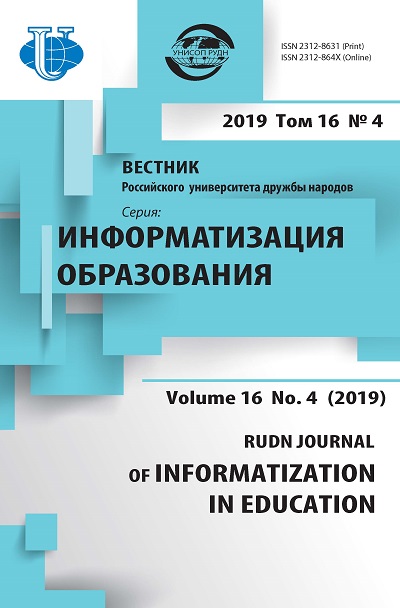Vol 16, No 4 (2019)
- Year: 2019
- Articles: 6
- URL: https://journals.rudn.ru/informatization-education/issue/view/1274
- DOI: https://doi.org/10.22363/2312-8631-2019-16-4
Full Issue
DIDUCTIC ASPECTS OF EDUCATION INFORMATIZATION
Digital education: from school for all to school for each
Abstract
Problem and goal. The article is devoted to the development of digital education. The gap between generations and social groups exacerbates the contradictions between the education system and the demands of the information society, and the increase in the volume, accessibility, speed of acquisition and exchange of knowledge has changed the style of knowledge of modern man. The key competence was the ability to distinguish important from unimportant, reliable from unreliable. Students need to purposefully develop digital identity. All this gives rise to a set of problems facing the modern school. The purpose of the study described in the article is to identify promising ways to digitalize the school, build a model of digital school and identify a set of factors that are important for the transformation of the school for all in the school for everyone. Methodology. In the course of the study, based on the analysis of existing approaches to the development of digital technologies and digitalization of education, the ways of formation and development of a digital school are revealed. The structure of the core of digital education providing comparability of the knowledge, values, skills and competences mastered and shown in various types of activity of the person is defined. This is the value, activity and content basis for the formation of digital socio-cultural educational environment. This core is proposed to be considered as a basis for the development of concepts of subject areas, GEF and educational programs at all levels of education. Results. The interpretation of the term «digital education» is given, which is understood as educational activity, the key factors of which are digital data, processing, exchange and analysis of which allow the individual to achieve new results of education in a specific sociocultural situation. According to the model, the digital school provides not only training and education, but also effective integration of the individual into a high-tech rapidly changing complex environment. The educational ecosystem is an integrative socio-cultural environment, in the center of which is not a teacher of a traditional school, but a student, surrounded by peers and adults who help him realize his personal educational trajectory. Conclusion. The article outlines the prerequisites for a new era-the era of digital education, formulated the definition of the term «digital education», justified the relevance of the development and the structure of the core of digital education, describes the model of digital school, presents the structure of the educational ecosystem and the effects of its implementation for different stakeholders.
 295-307
295-307


COMPUTER SCIENCE TEACHING
Application of the principles of pedagogical design in the design of informatics lessons
Abstract
 308-317
308-317


The training of masters of pedagogical education to the integrated teaching of the schoolchildren in mathematics and computer science
Abstract
 318-327
318-327


ELECTRONIC LEARNING SUPPORT TOOLS
Development of ICT competence among students when teaching inverse problems for differential equations with the use of computer technology
Abstract
 328-337
328-337


INNOVATION PEDAGOGICAL TECHNOLOGIES IN EDUCATION
Virtual reality: educational and methodological aspects
Abstract
 338-350
338-350


Evaluation of the effectiveness of the use of case-technology in teaching computer modeling of future teachers of informatics
Abstract
 351-364
351-364
















